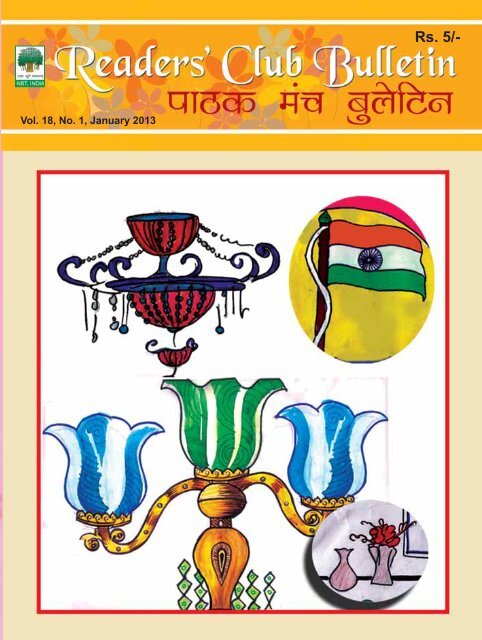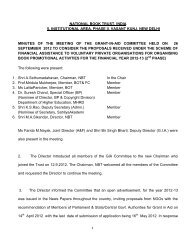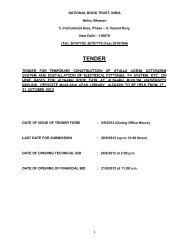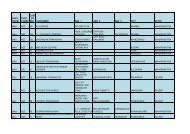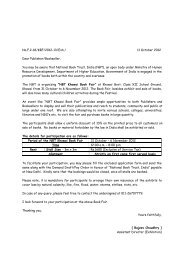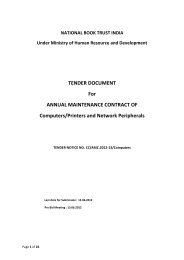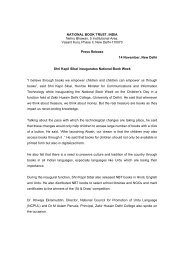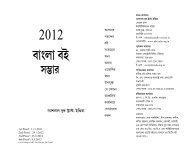January 2013 - National Book Trust India
January 2013 - National Book Trust India
January 2013 - National Book Trust India
Create successful ePaper yourself
Turn your PDF publications into a flip-book with our unique Google optimized e-Paper software.
Readers’ Club Bulletin<br />
ikBd eap cqysfVu<br />
Vol. 18, No. 1, <strong>January</strong> <strong>2013</strong> o"kZ 18] vad 1] tuojh <strong>2013</strong><br />
Editor / laiknd<br />
Manas Ranjan Mahapatra<br />
ekul jatu egkik=<br />
Assistant Editor / lgk;d laiknd<br />
Dwijendra Kumar<br />
f}tsUnz dqekj<br />
Production / mRiknu<br />
Narender Kumar<br />
ujsUæ dqekj<br />
Illustration / fp=kadu<br />
Young Girls from Ferozabad<br />
fiQjkstkckn dh ;qok efgyk,a<br />
Printed and published by Satish Kumar on behalf of<br />
<strong>National</strong> <strong>Book</strong> <strong>Trust</strong>, <strong>India</strong> and printed at Pushpak<br />
Press Pvt. Ltd., 203-204 DSIDC Shed, Okhla Industrial<br />
Area, Phase-I, New Delhi-110 020, and published at<br />
<strong>National</strong> <strong>Book</strong> <strong>Trust</strong>, <strong>India</strong>, Nehru Bhawan,<br />
5 Institutional Area, Phase-II, Vasant Kunj,<br />
New Delhi-110070. Editor: Manas Ranjan Mahapatra.<br />
Typeset at Deft Creations, H-44, Second Floor,<br />
South Extension, Part-1, New Delhi-110049.<br />
Contents/lwph<br />
tknwxj izksQslj Mk gfjd`".k nsoljs 2<br />
Sukhdev R. K. Tandon 6<br />
Multitalented Artist Roop N. Kabra 12<br />
I saw a Dream Divya Chauhan 15<br />
gkFkh dfork fodkl 15<br />
pkj cky dfork,a Mk- txnh'kpanz 'kekZ 16<br />
Chickenitaz..... R.K. Bharti 18<br />
Look Before You Leap Manas Ranjan Samal 20<br />
gkthiqj dk dsyk ufers’k Hkw"k.k 23<br />
izd`fr dh xksn essa /k/kdrk }hi Mk- eatw uk;j 24<br />
fpM+h vkSj fpM+k ds- vkj- 'kekZ 29<br />
taxy dk u;k lky deyflag pkSgku 31<br />
,d vkSj vusd vuU;k eksgu 31<br />
igsfy;ka y{eh [kUuk ^lqeu* 32<br />
Editorial Address / laikndh; irk<br />
<strong>National</strong> Centre for Children’s Literature, <strong>National</strong> <strong>Book</strong> <strong>Trust</strong>, <strong>India</strong>, Nehru Bhawan 5, Institutional Area,<br />
Phase - II, Vasant Kunj, New Delhi-110070<br />
jk"Vªh; cky lkfgR; dasnz] us”kuy cqd VªLV] bafM;k] usg: Hkou] 5 baLVhV~;w”kuy ,fj;k] Qsl&II] olar dqat] ubZ fnYyh&110 070<br />
E-Mail (bZ&esy ) : nbtindia@ndb.vsnl.net.in<br />
Per Copy/ ,d izfr Rs. 5.00 Annual subscription/okf"kZd xzkgdh : Rs. 50.00<br />
Please send your subscription in favour of <strong>National</strong> <strong>Book</strong> <strong>Trust</strong>, <strong>India</strong>.<br />
d`i;k Hkqxrku us'kuy cqd VªLV] bafM;k ds uke HkstsaA<br />
This Bulletin is meant for free distribution to Readers’ Clubs associated with <strong>National</strong> Centre for Children’s<br />
34 Literature. @ tuojh <strong>2013</strong> ikBd eap cqysfVu<br />
;g cqysfVu jk"Vªh; cky lkfgR; dasnzz ls tqM+s ikBd eapks dks fu%”kqYd forfjr fd;k tkrk gSA
An illustration workshop for the young<br />
was organised by <strong>National</strong> Centre for<br />
Children’s Literature, <strong>National</strong> <strong>Book</strong><br />
<strong>Trust</strong>, <strong>India</strong> at Ferozabad on 8-9<br />
December 2012 in collaboration with<br />
Brij Bhushan Memorial Society.<br />
Around sixty young girls participated in<br />
the workshop and drew coloured<br />
pictures for the text of this issue of the<br />
Bulletin.<br />
The two-day workshop was<br />
conducted by Shri Durga Dutt Pandey,<br />
noted artist. A session on <strong>Book</strong> Review<br />
together with an exhibition of books for<br />
the young adults was also organised on<br />
the occasion. In the past, NCCL had<br />
organised a two-day Reading Festival in<br />
Firozabad in 2010 in which interactive<br />
sessions with authors, reading sessions<br />
and a creative writing workshop were<br />
held.<br />
At Delhi, a seminar on “Holistic<br />
Development of Children: Face a <strong>Book</strong>”<br />
was organised in collaboration with the<br />
Centre for Child and Adolescent Well<br />
Being, Department of Socialwork,<br />
University of Delhi on 16 November<br />
2012. The seminar was inaugurated in<br />
graceful presence of Prof. Sushma Batra,<br />
Head of the Department, Prof. Sanjay<br />
Bhatt, Hon. Director of Centre for Child<br />
and Adolescent Well Being, and Mr. M.A.<br />
Sikandar, Director NBT. They shared their<br />
views about the value of books and the<br />
vital role it plays in our life.<br />
Promoting Love for <strong>Book</strong>s<br />
“<strong>Book</strong>s have an abiding value and<br />
serve our need as a companion when<br />
one is lonely. One can catch up a good<br />
one and just relish its content. Even<br />
during the time of leisure, we pick up<br />
books and magazines and refresh<br />
ourselves with new ideas and thoughts,”<br />
the speakers said. Dr. Ira Saxena, Dr.<br />
Harpreet Bhatia, Shri Somnath Dixit,<br />
Dr B.K. Tyagi, Ms Kusumlata Singh and<br />
Dwijendra Kumar conducted their<br />
respective sessions on the occasion.<br />
On 17 November, 2012 a workshop<br />
on enacting a story on Premchand’s<br />
masterpiece “Idgah” was organized at<br />
Project Concern International, <strong>India</strong>’s<br />
Shelter’s Home located in Bhango<br />
village of Mewat district in<br />
Haryana. The resource person was Mr.<br />
Hafiz Khan, a senior theatre expert from<br />
the panel of <strong>National</strong> School of Drama<br />
and TIE company. Along with the<br />
children from Shelter Home, children<br />
from adjacent villages also participated<br />
in this workshop.<br />
Readers’ Club Bulletin <strong>January</strong> <strong>2013</strong> / 1
kkjkokfgd foKku xYi<br />
tknwxj izksQslj<br />
Mk gfjd`".k nsoljs<br />
:ch dq'kokgk<br />
fiNys vad esa vkius i
uhys jax esa cny tkrk gSA bl rjg ;g<br />
izdk’k gekjs fy, thus dk lgkjk cu tkrk<br />
gSAß mlus ;g Hkh crk;k fd ;gka nl ?kaVs<br />
dh jkrsa gksrh gaSA ;gka ds fuoklh fnu esa<br />
vf/kd ls vf/kd le; rd izdk’k esa jgus<br />
dk iz;kl djrs gSa ftlls jkr vkjke ls<br />
chr ldsA<br />
Þvkids ;gka lcls cM+k dkSu gS\ß lat;<br />
us iwNkA<br />
Þ’kfu egkjkt!ß<br />
Þ’kfu egkjkt!ß vkidk eryc ‘kfu<br />
nsork ls gS\ß<br />
Þvki ,slk Hkh dg ldrs gSaA og vn~Hkqr<br />
‘kfDr;ksa okys gSaA mUgha ds }kjk bl xzg<br />
dk lkjk dke lapkfyr gksrk gSAß<br />
ÞvkSj iz/kkuea=hAß<br />
Þog jkst dk dke ns[krs gSaAß<br />
Þ,d ckr vkSj crkb, fd foKku esa<br />
vkius bruh mUufr dSls dj yh\ß<br />
Þgekjs ;gka gtkjksa & yk[kksa lkyksa ls<br />
;g fo/kk izpfyr gS A mlh esa ge mUufr<br />
djrs tkrs gaSAß<br />
ÞD;k vki gesa vius foKku&dsUnz<br />
fn[kk;asxs\ß<br />
Þugha! {kek djsaA blds fy, eq>s vuqefr<br />
ugha gSA vc tcfd eaxy xzg vius dks<br />
‘kfDr’kkyh cukuk pkgrk gS] gekjs ;gka<br />
lqj{kk cgqr dM+h gks xbZAß<br />
dkQh nsj ?kwweus ds ckn tc pyus dh<br />
ckr vkbZ rks izksQslj us iwNk&ÞD;k gekjk<br />
;ku vkids xzg ds oy; ikj djds varfj{k<br />
easa tk ldsxk\ß<br />
^^blds ckjs esa gekjs varfj{k fo’ks”kK<br />
gh crk,axsA vkb, varfj{k dsUnz pysaA^^<br />
varfj{k dsUnz ds oSKkfudkssa us crk;k<br />
fd ‘kfu xzg dk xq:Rokd”kZ.k vf/kd gksus<br />
ds dkj.k] bl ;ku }kjk oy; ikj djus<br />
esa ck/kk vk ldrh gSA blfy, gesa vius<br />
fdlh jkdsV ds lgkjs bl ;ku dks varfj{k<br />
esa Hkstuk gksxkA blds fy, ‘kh/kz gh rS;kjh<br />
Hkh dj yh xbZA<br />
dqN gh nsj esa ladsr feys fd ;ku<br />
rS;kj gSA izksQslj MsfoM vkSj cPps vius<br />
;ku esa cSB x,A ‘kfu dk jkdsV pyk vkSj<br />
mlh ds lkFk izksQslj MsfoM us viuk ;ku<br />
pkyw dj fn;kA dqN gh le; ckn os cM+h<br />
rsth ls ,d ds ckn ,d oy; ikj djrs<br />
x,A varfj{k esa igqapdj ‘kfu dk jkdsV<br />
vyx gks x;kA<br />
^^vady] vc ?kj pfy,A^^ lHkh cPpksa<br />
us ,d Loj esa dgkA<br />
Readers’ Club Bulletin <strong>January</strong> <strong>2013</strong> / 3
^^Bhd gSA vc ?kj pyrs gSaA^^ galrs gq,<br />
izksQslj us dgkA<br />
^^vady] Mk- cukZMZ dh Mk;jh rks lqjf{kr<br />
gS Ukk^^A<br />
^^gka^A^^ izksQslj us tsc VVksydj dgk<br />
&^^esjk fopkj gS bl ;k=k dh ;g cgqr<br />
cM+h miyfC/k gSA^^<br />
^^gkaA blesa cgqr ls os jgL; gks ldrs<br />
gSa tks 'kfu okyksa us gels fNik, gSaA vPNk<br />
gqvk] mUgsa bldk irk ugha yxkA^^ izksQslj<br />
us dgkA<br />
vpkud ‘kf’k ph[kh &^^vady] oks nsf[k,]<br />
vkx mxyrk gqvk varfj{k ;ku] bls rks eSaus<br />
'kfu ds varfj{k dsUnz esa ns[kk FkkA^^<br />
twyh dqekjh<br />
4 @ tuojh <strong>2013</strong> ikBd eap cqysfVu
^^vksgA bldk vFkZ gS fd Mk;jh dh<br />
ckr mUgsa irk py xbZ gSA rHkh os gesa u”V<br />
djus vk jgs gSaA^^ izksQslj us dgkA<br />
^^D;k]^^ cPpksa us ?kcjk, Loj esa dgkA<br />
izksQslj us ;ku ds ehVjksa dsk ns[krs gq,<br />
dgk&^^?kcjkvks ughaA<br />
;ku vHkh dkQh nwj gSA gesa rqjar muds<br />
varfj{k {ks= ls ckgj gksuk gSA<br />
blds ckn os gekjk dqN ugha fcxkM+<br />
ldsaxsA^^<br />
izksQslj us ;ku dh xfr c
Sukhdev<br />
R. K. Tandon<br />
Namrata Gupta<br />
In the history of <strong>India</strong>’s revolution,<br />
Sukhdev has a special place. In the Lahore<br />
Conspiracy case he was declared accused<br />
along with Bhagat Singh and Rajguru and<br />
was later hanged with them. He believed<br />
that through armed revolution, the<br />
British could be driven out of the country<br />
and the <strong>India</strong>ns could be independent. For<br />
this purpose he devoted his whole life.<br />
This great revolutionary and<br />
colleague of Bhagat Singh was born on<br />
15 May 1907 in Lyallpur, Punjab (now<br />
in Pakistan). His father Ram Lal Thapar<br />
died three months before his birth. His<br />
uncle Lala Achint Ram brought him up.<br />
Another uncle of his, Lala Anant Ram<br />
was a national leader and at the time of<br />
Sukhdev’s birth he was facing conviction<br />
6 @ tuojh <strong>2013</strong> ikBd eap cqysfVu
under the marshal law. Sukhdev’s early<br />
education took place in Lyallpur. At the<br />
age of five he got admission in Arya High<br />
School. In 1922, he passed his High<br />
School exams. After that he went to<br />
Lahore for further studies. But his heart<br />
was somewhere else. He was a<br />
revolutionary and in Lahore he came<br />
into contact with another revolutionary,<br />
Bhagat Singh. Both were the students of<br />
D.A.V. College, Lahore. They joined<br />
hands with several other young men and<br />
formed a group, which later became an<br />
organization. Chandra Shekhar Azad,<br />
Jatindra Nath Das and Sachindra Nath<br />
Sanyal were the guiding forces behind<br />
the organization. This organization was<br />
very active in Punjab that made the<br />
British Government nervous and alert.<br />
Both Sardar Bhagat Singh and<br />
Sukhdev formed Naujawan Bharat<br />
Sabha at Lahore. Its main objective was<br />
to give political education to young<br />
men so that the message of revolution<br />
travelled fast. Initially Bhagat Singh was<br />
its leader and later this work was given<br />
to Sukhdev. Sukhdev worked very well.<br />
He brought raw material from different<br />
sources for a bomb factory. At this time,<br />
he was only twenty years old.<br />
Sukhdev loved Hindi language though<br />
it was not his mother tongue. He tried<br />
to learn it and later became a campaigner<br />
of Hindi. He used to teach Hindi to his<br />
friends and tried to explain its<br />
importance to them. In the revolutionary<br />
group, Sukhdev was called ‘Villager’,<br />
because he was a very simple man. His<br />
behaviour, his lifestyle and dressing<br />
sense were just like village-folk. He was<br />
an ordinary man with an extraordinary<br />
outlook.<br />
On one hand, he was a cheerful man<br />
and even small matters made him laugh<br />
heartily just like an innocent person. On<br />
the other hand, Sukhdev’s silence was<br />
disturbing. It seemed that some severe<br />
pain inside his heart was hurting him<br />
emotionally and for hours together he<br />
used to ponder over something or the<br />
other. The smile on his face showed his<br />
contempt over social evils, conservatives<br />
and differences of political opinions.<br />
Sukhdev was one of the senior most<br />
leaders and an active member of the<br />
Hindustan Socialist Republican<br />
Association. He started study circles at<br />
the <strong>National</strong> College (Lahore) in order<br />
to delve into <strong>India</strong>’s past as well as to<br />
scrutinize the finer aspects of the<br />
Russian Revolution.<br />
Readers’ Club Bulletin <strong>January</strong> <strong>2013</strong> / 7
Sukhdev was a devoted man. If he<br />
wanted to do something then nothing<br />
could change his decision. When he was<br />
a student and had no connection with the<br />
revolutionary party, he had got tattooed<br />
the word Om on his hand. But later, this<br />
symbol became a prominent<br />
identification and he wanted to remove<br />
it. In those days, in Agra, nitric acid was<br />
used for making bombs. Without telling<br />
anybody, he put a lot of acid on the<br />
tattooed-word Om. By the evening, he<br />
got plenty of burn marks at that place and<br />
he got fever but he did not disclose this<br />
to anybody and behaved normally as if<br />
nothing had happened. Chandra Shekhar<br />
Azad and Bhagat Singh were very angry<br />
with him, when they came to know about<br />
this incident. Laughingly, Sukhdev said,<br />
“the symbol of identification will be<br />
destroyed and I would be able to realize<br />
the capacity of acid.” After some time<br />
when the injury healed, some remains of<br />
the tattoo were still there on his hand.<br />
He decided to remove it also and for this<br />
he put a light candle below his hand to<br />
burn the skin. This caused him severe<br />
pain and injury.<br />
Sukhdev was not present in the<br />
meeting of the Central Committee in<br />
which it was decided to throw a bomb in<br />
the Delhi Assembly. Bhagat Singh<br />
pleaded that he should be sent for this<br />
mission but the members did not agree<br />
with him because the Punjab police was<br />
on his trail for the murder of Saunders.<br />
The Central Committee decided to send<br />
two other persons for this work. After<br />
two or three days when Sukhdev came<br />
to know about this, he vehemently<br />
protested the decision. He believed that<br />
only Bhagat Singh could explain the<br />
political philosophy of bomb throwing,<br />
if he was arrested. He discussed the<br />
matter with Bhagat Singh and asked him<br />
to execute the plan but when the Central<br />
Committee refused to give permission<br />
to Bhagat Singh he again discussed the<br />
matter with him. Looking at his adamant<br />
attitude, the Committee had to change<br />
its decision. Sukhdev left the same<br />
evening for Lahore without meeting<br />
anybody. Personally he had a great<br />
affection for Bhagat Singh but for the<br />
sake of idealism he had to sacrifice his<br />
dearest friend and in a way he was<br />
instrumental for sending Bhagat Singh<br />
to the jaws of death.<br />
After the Assembly Bomb episode,<br />
Sukhdev and other members continued<br />
8 @ tuojh <strong>2013</strong> ikBd eap cqysfVu
Namrata Gupta<br />
to do the party work. He established a<br />
bomb factory with the help of Yashpal<br />
and other colleagues. After some time<br />
the police located this bomb factory and<br />
Sukhdev was arrested.<br />
Sukhdev also participated in the<br />
1929 Prison Hunger Strike to protest<br />
against the inhuman treatment meted out<br />
to the inmates. During the period of trial,<br />
he was indifferent towards his case<br />
because he was not expecting justice<br />
from the enemy’s court. On 23 March<br />
1931, Sukhdev was hanged at Lahore<br />
jail along with his dear friends Bhagat<br />
Singh and Rajguru.<br />
Sukhdev wrote a letter to Mahatma<br />
Gandhi just prior to his hanging,<br />
protesting against the latter’s<br />
disapproval of revolutionary tactics.<br />
This letter throws light on the<br />
disparities between the two major<br />
schools of thought among the <strong>India</strong>n<br />
freedom fighters. Gandhiji was<br />
negotiating with the Government for the<br />
Readers’ Club Bulletin <strong>January</strong> <strong>2013</strong> / 9
elease of political prisoners not<br />
convicted of violence. On the other<br />
side, he was also appealing to the<br />
revolutionaries to stop their activities,<br />
as he believed that freedom could not<br />
be achieved through violence. The<br />
letter was published in ‘Young <strong>India</strong>’ on<br />
23 April 1931, after the execution of<br />
Bhagat Singh, Rajguru and Sukhdev. The<br />
letter reads as......<br />
"Most Gracious Mahatma Ji, recent<br />
reports show that, since the successful<br />
termination of your peace negotiations,<br />
you have made several public appeals to<br />
the revolutionary workers to call off<br />
their movement at least for the present<br />
and give you a last chance to try your<br />
non-violent cult…The Congress is<br />
bound by its Lahore resolution to carry<br />
on the struggle relentlessly till the<br />
Bhavana<br />
10 @ tuojh <strong>2013</strong> ikBd eap cqysfVu
complete Independence is achieved. In<br />
face of the resolution, the peace and<br />
compromise is nothing but a temporary<br />
truce which only means a little rest to<br />
organize better forces on a larger scale<br />
for the next struggle… as is evident<br />
from the very name—The Hindustan<br />
Socialist Republic Party—the<br />
revolutionaries stand for the<br />
establishment of the Socialist Republic<br />
which is not a half-way house. They are<br />
bound to carry on the struggle till their<br />
goal is achieved and their ideal<br />
consummated. But they would be quite<br />
apt to change their tactics according to<br />
the changing circumstances and<br />
environment.<br />
Revolutionary struggle assumes<br />
different shapes at different times. It<br />
becomes sometimes open, sometimes<br />
purely agitational and sometimes a<br />
fierce life-and-death struggle. In the<br />
circumstances, there must be special<br />
factors, the consideration of which may<br />
prepare the revolutionaries to call off<br />
their movement…Since your<br />
compromise you have called off your<br />
movement and consequently all of your<br />
prisoners have been released. But, what<br />
about the revolutionary prisoners.<br />
Dozens of Ghadar Party prisoners<br />
imprisoned since 1915, are still rotting<br />
in jails; in spite of having undergone the<br />
full terms of their imprisonment.<br />
Prisoners are buried in these living<br />
bombs, and so are dozens of Babbar<br />
Akali prisoners. Deogarh, Kakori,<br />
Machhua Bazar and Lahore Conspiracy<br />
Case prisoners are amongst those<br />
numerous who are still locked behind<br />
the bars. More than half a dozen<br />
conspiracy trials are going on at Lahore,<br />
Delhi, Chittagong, Bombay, Calcutta and<br />
elsewhere. Dozens of revolutionaries<br />
are absconding and amongst them are<br />
many females. More than half a dozen<br />
prisoners are actually waiting for the<br />
executions. What about all these<br />
people?<br />
The three Lahore Conspiracy Case<br />
condemned prisoners, who have<br />
luckily come into prominence and<br />
who have acquired enormous public<br />
sympathy, do not form the bulk of the<br />
revolutionary party. Their fate is not<br />
the only consideration before the<br />
party. As a matter of fact the<br />
executions are expected to do greater<br />
good than the commutation of their<br />
sentences… Therefore we request you<br />
either to talk to some revolutionary<br />
leaders, or to stop these appeals…<br />
Hope you will kindly consider the<br />
above request and let your view be<br />
known publicly."<br />
"From the NBT <strong>Book</strong><br />
Hanged for their Patriotism"<br />
Readers’ Club Bulletin <strong>January</strong> <strong>2013</strong> / 11
Multitalented Artist – Leonardo da Vinci<br />
Roop N. Kabra<br />
Puja Gupta<br />
It may be leaves of a tree, hands of a man,<br />
rocks, starfilled sky, raining clouds or<br />
thundering lightning - he painted so nice<br />
and lively pictures of these that<br />
whosoever saw these felt dumbfounded.<br />
There was none equal to him in painting<br />
light and shade pictures. Famous portrait<br />
of Mona Lisa and Jesus Christ’s Last<br />
Supper are immortal creations of this<br />
multi-talented artist Leonardo da Vinci,<br />
painter of innumerable pictures of<br />
child’s smile, groups of flying birds,<br />
different faces of men, old people,<br />
warriors, nerves inside the skin and<br />
12 @ tuojh <strong>2013</strong> ikBd eap cqysfVu
muscles etc. Leonardo da Vinci was not<br />
only a painter skilled architect, sculptor,<br />
engineer, draughtsman, astronomer,<br />
botanist, zoologist and anatomist etc. He<br />
was the first person to sketch out the<br />
inside of the brain on wax. He also to<br />
explained the functioning of heart and<br />
pupils of eyes as also. Why leaves are<br />
arranged in the branches in one<br />
particular way was also investigated by<br />
him.<br />
He also thought differently<br />
compared to the great thinkers of the<br />
fifteenth century like Aristotle, He was<br />
a modern scientist of his period.<br />
Leonardo was very curious and he felt<br />
that nothing was beyond his minute<br />
observation and microscopic intellect.<br />
He had explained even before<br />
Copernicus that the sun doesn’t revolve<br />
round the earth and that the earth is also<br />
a planet like the moon. It was he who<br />
suggested for the first time that the study<br />
of the surface of the moon should be<br />
done with the help of a huge magnifying<br />
lense. Observing the lightning and the<br />
thunder, he concluded that light travels<br />
faster than sound.<br />
He also succeeded in understanding<br />
the blood circulation system and<br />
thickening of arteries. He was the first<br />
to find out that the annual rings in the<br />
stem of a tree can give us information<br />
about the age of the tree and also the<br />
annual details of humidity.<br />
The praise of Leonardo’s talents<br />
doesn’t end here. Even much before the<br />
industrial revolution when there were<br />
no screws and screw drivers, he had<br />
invented rachet, wrench, jack, kharad<br />
and even a crane which could lift a<br />
church. He was the first scientist to<br />
suggest that wind power can also give<br />
energy and made an air-conditioning<br />
machine and hygrometer.<br />
This great artist who called wars<br />
“brutal frenzy” also worked in the army<br />
as engineer. He designed a doublewalled<br />
cruiser so that when the outer<br />
cover is destroyed, the ship could flout<br />
on the inner cover.<br />
His study, experimentation,<br />
sketching, observation in the field of<br />
aerodynamics was original. He said,<br />
“Birds fly according to a mathematical<br />
rule and even men has this ability if they<br />
follow the birds”.<br />
He would open the doors of the<br />
cages allowing the birds to fly and<br />
studied their flight, rising steps and<br />
spreading of wings. His observation<br />
was so quick, keen and sharp that<br />
whatever he saw, he could draw exactly<br />
Readers’ Club Bulletin <strong>January</strong> <strong>2013</strong> / 13
the similar even if it were flying birds,<br />
running vehicles and horses.<br />
He had thoroughly thought about the<br />
gliders, parachute and helicopter etc.<br />
Such a great, unique, talented painter,<br />
scientist, engineer, musician, architect<br />
and biologist, Leonardo da Vinci was<br />
born in 1452 in Florence, Italy near<br />
Vinci.<br />
Right from childhood he was<br />
extraordinarily curious. He had a thirst<br />
to learn, know and find out the secret of<br />
everything. At the age of 15 years with<br />
training under the great master painter<br />
Verokkyo, he astonished him<br />
with his artistic and wonderful<br />
paintings.<br />
He was a well-built and<br />
handsome person. He was a<br />
very good horse rider and an<br />
extempore poet. He sang his<br />
compositions on the musical<br />
instrument made by himself.<br />
At the age of 28 he had been<br />
recognized as the best painter<br />
of the period among the<br />
painting masters such as<br />
Michelangelo, Raphel and<br />
Battervali.<br />
He was very impatient<br />
and cynical. He liked to keep away from<br />
crowd. He was never satisfied with his<br />
work. He was so fast in planning new<br />
projects that the previous work<br />
remained incomplete. He used to say<br />
“I want to do miracle”. Later he<br />
repented that he had wasted lot of time.<br />
Six thousand pages written and sketched<br />
by him are still in Europe. He also<br />
learnt the art of reverse writing.<br />
This most talented, wonderful man<br />
died at the age of 67. None else in the<br />
history matches with his great<br />
personality. No one like him has ever<br />
been born so far.<br />
Puja Gupta<br />
A-438, Kishore Kutir, Vaishali Nagar<br />
Jaipur– 302021 (Rajasthan)<br />
14 @ tuojh <strong>2013</strong> ikBd eap cqysfVu
My Page<br />
I saw a Dream<br />
Divya Chauhan<br />
Manu<br />
I saw a dream…<br />
a dream which was never new<br />
I saw a dream<br />
a dream of being with you.<br />
It was a bright sunny morning<br />
the sky was blue<br />
there was a silent cool breeze<br />
and just ‘Me’ and ‘You’ !<br />
gkFkh<br />
dfork fodkl<br />
fdruk lqUnj] fdruk I;kjk<br />
outhou dk U;kjk<br />
lcdh vka[kksa dk rkjk<br />
cPpksa dk gS og ;kjk<br />
euekSth gS lhjr<br />
yacs ia[ks gS dku<br />
gkFkh gh gS og tho/kkjhA<br />
lcls vtwck] iw.kZr% “kkdkgkjh A<br />
I saw a dream…<br />
a dream of us lying on the grass<br />
watching clouds, high above<br />
as the time passed<br />
We were reading in the shade<br />
the birds were singing to us<br />
as together there we laid<br />
there was no one to fuss.<br />
Ahlcon International School<br />
Mayur Vihar Phase-I<br />
Delhi-110091<br />
Neera Gupta<br />
Readers’ Club Bulletin <strong>January</strong> <strong>2013</strong> / 15
pkj cky dfork,a<br />
Mk- txnh'kpanz 'kekZ<br />
dFkuh&djuh<br />
yEch nkSM+<br />
yxs nkSM+us ,d lkFk gh<br />
canj vkSj fl;kj<br />
dkSu nkSM+ dj igys igqaps<br />
taxy ds ml ikj!<br />
vkdk'k<br />
Hkk”k.k nsus yxk HksfM+;k<br />
mls fey x;k eap<br />
bl pquko esa mls thr dj<br />
cuuk Fkk ljiap<br />
vkxs tkdj ?kuh >kfM+;ksa<br />
dk ns[kk vEckj<br />
:dk fl;kj] dwndj canj<br />
Tkk igaqpk ml ikjA<br />
taxy dh lsok ds mlus<br />
okns fd, vusd<br />
lcus lkspk bldh<br />
dFkuh&djuh jgh u usd<br />
laxhrk frokjh<br />
jtuh<br />
16 @ tuojh <strong>2013</strong> ikBd eap cqysfVu
vaxwj<br />
lnhZ<br />
yyd jgk gS lnhZ dk nksuk<br />
d.k&d.k Hkh gks mBk lyksuk<br />
T;ksagh fcxqy cTkk fBBqju dk<br />
xawt mBk gS dksuk&dksuk<br />
mxrk gqvk lqugyk lwjt<br />
fn[krk pedhyk e`x&NkSuk<br />
vksl cuh gS eksrh&tSlh<br />
Mky jgh gS tknw Vksuk<br />
f'kok dqekj<br />
dapks&tSls xksy&eVksy<br />
gjs&gjs ehBs vaxwj<br />
ysdj vk, ubZ cgkj<br />
feyrs lHkh txg Hkjiwj<br />
xqPNksa ls xnjkrh csy<br />
Qy yxrs dqN Åaps nwj<br />
tgka ykseM+h dk vankt<br />
gqvk dHkh dk pdukpwj A<br />
Qwyksa ds xqPNs eqLdk,<br />
gydh /kwi] yx jgh lksuk<br />
ckal&cjkcj yEch jkrsa<br />
fruds&tSlk fnu gS cksuk A<br />
uhrw flag<br />
laiknd ^cqyan cukl*<br />
iks- fxywaM&313207 ¼jktLFkku½<br />
Readers’ Club Bulletin <strong>January</strong> <strong>2013</strong> / 17
Chickenitaz : Centre of Maya Civilisation<br />
R.K. Bharti<br />
Between the 3 rd and 9 th centuries A.D.,<br />
the Mayas built some pyramids all<br />
across eastern Mexico and into modern<br />
Belize, Guatemala, Honduras, and EI<br />
Salvador. Made of stone blocks held<br />
together with strong lime mortar, Mayan<br />
pyramids were built at steeper angles<br />
than Egyptian ones. The staircases<br />
sometimes got narrower as they rose,<br />
to make the pyramids seem even taller<br />
and steeper. This also drew attention to<br />
the rituals performed in the temple<br />
chamber at the top. Crowds gathered at<br />
the base, but only priests could climb<br />
to the sacred heights.<br />
The Mayas were skilled astronomers<br />
and laid out their pyramids according to<br />
the sun, moon, and stars. They also<br />
18 @ tuojh <strong>2013</strong> ikBd eap cqysfVu
developed yearly and sacred calendars,<br />
a system of mathematics, and their own<br />
language of picture-writing or “glyphs”.<br />
This has still not been fully deciphered.<br />
City Kigdom<br />
The Maya did not have a single capital<br />
or king. Instead each city governed<br />
itself under its own ruler. One important<br />
later city was Chichen Itza in the Yucatan<br />
Peninsula. There were many major<br />
religious and administrative buildings<br />
there, including the famous pyramid EI<br />
Castillo. The stone pillars in the<br />
architecture show the influence of the<br />
Toltecs, a neighbouring culture.<br />
Over 1,000 years ago, this was the<br />
centre of largest Maya civilization.<br />
Chichen Itza rose to prominent Mayan<br />
city but strangely, the people abandoned<br />
the city suddenly. There was never a<br />
Mayan kingdom and wars were<br />
constantly being fought between the<br />
cities. This may have played a part in<br />
the downfall of the civilization. But the<br />
Maya are still around. About nine<br />
million of them live in central America<br />
and 31 Maya languages are spoken.<br />
The pyramid of Kukulkan, located at<br />
the centre of Chichen Itza, is one of the<br />
greatest Mayan structures. Originally<br />
each side had 91 steps and with the<br />
addition of the platform at the top, there<br />
are 365 steps, one for each day of the<br />
year. The stone steps are not so steep,<br />
but the optical illusion of a vertical<br />
climb is legendary.<br />
At mid-afternoon on the days of the<br />
spring and autumn equinoxes, the<br />
shadow that covers the northeast angle<br />
of the pyramid is reflected on the<br />
stairway and forms triangles of light and<br />
shade that look like the movement of a<br />
serpent. This effect is more impressive<br />
because it touches a large head of<br />
Kukulkan i.e. feathered serpent at the<br />
bottom of the stairway, making it appear<br />
as if the serpent was descending from<br />
the pyramid. Such an effect could only<br />
be obtained by precise architectural and<br />
astronomical measurements.<br />
In the Temple of the Red Jaguar,<br />
archaeologists discovered the Throne of<br />
the Jaguar, which may have been a throne<br />
for the high priest.<br />
The Temple of the Warriors has<br />
thousand pillars sculptured in bas-relief,<br />
which have retained much of their<br />
original colour. Murals once adorned<br />
its walls. It is surrounded by numerous<br />
reined building known as the Group of<br />
a Thousand Columns.<br />
Cenotes are a common natural<br />
formation in Yucatan. Under the earth’s<br />
surface are huge dripstone caves filled<br />
with ground water. Sometimes the<br />
chalky soil breaks away, revealing a view<br />
of and access to the depths below. The<br />
Cenote of Sacrifice was reserved for<br />
rituals related to human sacrifice for<br />
pleasing the rain god.<br />
56, Nagin Lake<br />
Peeragarhi, Delhi-110085<br />
Readers’ Club Bulletin <strong>January</strong> <strong>2013</strong> / 19
Look Before You Leap<br />
Manas Ranjan Samal<br />
Sageeta Trivedi<br />
Once there was a tiger in a jungle. He<br />
was suffering from high temperature.<br />
His family doctor, the old hare had<br />
prescribed him to take the young fresh<br />
blood of a fox. The tiger had become<br />
old, lost his teeth and was very feeble,<br />
helpless and weak. Hunting had almost<br />
become impossible on his part. He was<br />
dependent upon his own fate and had<br />
been staying near a pond in the dense<br />
forest. By chance only that he could hunt<br />
any animal while they came near the<br />
pond, else remained without food.<br />
A young fox with a sound physique<br />
came regularly to drink water in the<br />
pond. The tiger wanted to taste the soft<br />
flesh of the fox. Everyday he tried to<br />
entrap the fox telling him soft words<br />
20 @ tuojh <strong>2013</strong> ikBd eap cqysfVu
about the old friendship with his father<br />
that they were bosom friends. “He used<br />
to visit my place with your mother<br />
almost everyday. He could sing in a very<br />
sweet voice and possessed a very good<br />
health. In his memory, I have preserved<br />
his violin which he used to play. You do<br />
not know how many animals we have<br />
killed in our youth and earned<br />
uncountable sins. That was the reason<br />
why your father, my wife and all my sons<br />
have died. There is no one left whom I<br />
can call my own. So I am leading a pious<br />
life here at the advice of a prophet and<br />
bathe early in the morning in the river<br />
Ganga. I have become vegetarian and<br />
worship every morning.”<br />
The fox was very clever and did not<br />
come near the haunting tiger. There<br />
lived a monkey in the forest, a close<br />
Vanshika Sharma<br />
Readers’ Club Bulletin <strong>January</strong> <strong>2013</strong> / 21
Vanshika Sharma<br />
friend of the tiger. The tiger revealed<br />
the hidden agenda to his friend. Friend<br />
in need is a friend indeed. The monkey<br />
hit upon a plan and asked the tiger to<br />
sleep over a narrow canal and cover his<br />
body with green leaves and flowers so<br />
as to present false view of a bridge. The<br />
tiger followed the idea in toto. In the<br />
meanwhile, the monkey went to invite<br />
the fox and told him that a new bridge<br />
had been constructed and was being<br />
inaugurated by the elephant. “As you had<br />
been to your uncle’s house, so please<br />
do visit it today at any cost.”<br />
But the fox smelt a rat. From a<br />
distance, he watched whether it was a<br />
real or fake bridge. The tiger on the<br />
other hand could not stop its tail from<br />
trembling with joy, at the prospect of<br />
catching the fox. As a result, many of<br />
the green leaves and the flowers<br />
covering the tiger’s tail tumbled and fell<br />
down. Now the tail could be seen from<br />
a distance and the clever fox came to<br />
know about the plan of the monkey. The<br />
tiger fled away. From that day, he never<br />
came near the pond.<br />
144-Govt. HB Tenement<br />
Charbatia-754028, Cuttack (Odisha)<br />
22 @ tuojh <strong>2013</strong> ikBd eap cqysfVu
esjk iék<br />
gkthiqj dk dsyk<br />
ufers’k Hkw"k.k<br />
dq- 'kkjnk<br />
dsyk! dsyk! dsyk!! tSls gh dksey ds<br />
dkuksa esa ;g vkokt xwath og gM+cM+k dj<br />
mBh vkSj ikik vkSj fd”kksj dks txkrs gq,<br />
cksyh% mBks&mBk]s gkthiqj vk x;k A ikik<br />
us mB dj f[kM+dh ds ckgj utj nkSM+kbZA<br />
Vªsu gkthiqj LVs”ku ij [kM+h Fkh vkSj<br />
jkr ds ,d ct jgs FksA bruh jkr esa<br />
f[kM+dh ds cxy ls]* dsyk! dsyk! gkthiqj<br />
dk ehBk&ehBk dsyk*! cksyrs gq, ,d dsyk<br />
okyk xqtjk A dksey ikik ls cksyh] ikik<br />
dsyk! ikik us dsys okys dks cqyk;k vkSj<br />
mlds nke iwNsA m/kj fd”kksj dsys ds ckjs<br />
esa tkuus ds fy, mRlqd FkkA<br />
dksey iwN cSBh% vady! gkthiqj esa<br />
dkSu&dkSu ls dsys gksrs gSaSA dsys okyk<br />
cksyk % ^^eqy gks x;k A<br />
:ch jkBkSj<br />
lariky Ldwy<br />
gkthiqj ¼fcgkj½<br />
Readers’ Club Bulletin <strong>January</strong> <strong>2013</strong> / 23
izd`fr dh xksn essa /k/kdrk }hi<br />
Mk- eatw uk;j<br />
dq- f'kokuh jkBkSj<br />
vUMeku fudksckj ds je.khd }hi izd`fr<br />
izsfe;ksa dh dzhM+kLFkyh gSA oSls rks 572<br />
Vkiqvksa dh yfM+;ksa esa lHkh }hi vius izkd`frd<br />
NVk ds fy, fo’ofo[;kr gSaA ysfdu bu<br />
n`'; fiz; gjhfrek vkss vuks[kh yxhA oSls rks izk;% lHkh }hi<br />
dkQh euksgkjh gaS ysfdu Tokyk}hi ftl<br />
ij vkcknh ugha gS] ;k=k vn~Hkqr yx jgh<br />
FkhA cSju }hi ,d lfdz; Tokykeq[kh dks<br />
vofLFkr djrk gSA iksVZCys;j }hiksa dh<br />
jkt/kkuh gS vkSj iksVZCys;j ls 6 ls 7 ?kaVs<br />
esa ty;ku }kjk }hi dh nwjh r; dh tk<br />
24 @ tuojh <strong>2013</strong> ikBd eap cqysfVu
ldrh gSA vkt ls nks o"kZ iwoZ rd Tokykeq[kh<br />
lq’kqIr Fkh vkSj ty;ku ;k=k laHko Fkh<br />
blfy, ekSdk ikdj }hi rd igqaapus dk<br />
izØe izkjaHk gqvkA<br />
T;knkrj ;k=k,a jkf= esa vk;ksftr gksrh<br />
gSa o lqcg ds /kaq/kyds rd }hi ds lehi<br />
igqapk tkrk gSA jkf= dk lQj vkjkenk;d<br />
FkkA eu esa meax o mYykl Fkk fd lw;Z<br />
jf'e ds QwVrs gh Tokyk }hi dk n'kZu<br />
gksxk A lqcg ds 4 cts ls gh tgkt esa<br />
gypysa 'kq: gks xbZA lHkh }hi ds lehi<br />
igqapus ds [kcj ls dkQh izlUufpr Fks vkSj<br />
fdlh uk;kc [kkst ij fudys oSKkfud dh<br />
Hkkafr ukfodksa ls T;knk ls T;knk tkudkjh<br />
}hi ds lUnHkZ esa ys jgs Fks A<br />
rHkh gekjk tgkth csM+k }hi ls djhc<br />
100 eh- dh nwjh ij yaxj lesr Bgj x;kA<br />
jkLrs esa geus dksjyks ls vVh iM+h uUgs<br />
fc[kjs }hikssa dsk ns[kk] caxky dh [kkM+h esa<br />
Mksyrh MksyfQuksa dks ns[kk tks lewgksa esa<br />
lkxj lrg ij Qqnd jgh FkhaA vUMeku<br />
lkxj dh rst rjkZj 'kkdZ eNyh ds Hkh<br />
n'kZu gq,A ysfdu vR;ar yqHkkous yxs<br />
/kqa/kyds esa nedrs gq, jax&fcjaxs euksgkjh<br />
IydaVuksa dh iztkfr;ka tks leqnzh ty esa<br />
lrjaxh jks'kuh fc[ksj jgs Fks vkSj ygjksa ds<br />
lkFk vka[k fepkSyh [ksy jgs Fks A<br />
bu lcds chp lw;Z jf'e;ksa dh ped<br />
ls /kqa/kqyds esa cSju ij fLFkr Tokykeq[kh<br />
jg&jgdj /kqvka o ok"i folftZr dj jgk<br />
FkkA }hi ds pkjksa vksj gfj;kyh Fkh ij<br />
chpksachp 'kadqvksa dh drkjsa yxh Fkha] ykok<br />
dh fc[kjh pêkusa leqnz rd ydhj ds<br />
leku f[kaph pyh vkbZ FkhaA gekjs tgkt<br />
dk dIrku] caxky dh [kkM+h esa tgkt<br />
pykus esa ekfgj] vkt bZ'oj dh oanuk dj<br />
jgk Fkk fd vkt ygjsa 'kkar jgsaA ;fn<br />
vuk;kl gh iz[kj ygjsa] lw;Z dh jks'kuh<br />
dh xehZ o cSju }hi dh xehZ ls mÙksftr<br />
o m}sfyr gksxh rks }hi ij mrjuk laHko<br />
ugha gksxkA lg;k=h ykbQ tSdsV dks iguus<br />
dh izfØ;k ls okfdQ gks jgs FksA<br />
ty;ku ij ca/kk ykbQ cksV ikuh esa<br />
mrkjk x;k vkSj pkj&pkj ;kf=;ksa dks<br />
NksVh lh ykbQ cksV ij lokj djds }hi<br />
rd igq¡pkus dk izØe izkjaHk gqvk A ftanxh<br />
esa igyh ckj ykbQ tSdsV gkFk esa Fkek;k<br />
x;kA mls igurs&igurs thou dh j{kk<br />
ds dneksa dks ljkgrs gq,] eSaus vius<br />
lg;kf=;ksa dks lkgl ds lkFk tgkt ls<br />
ykbQ cksV ij Nyk¡x yxkrs ns[kk] rks<br />
[kqn Hkh lkgl cVksjk vkSj vius VuZ ds<br />
bartkj esa eSaus tgkt ds dIrku ls ckrphr<br />
dh dksf'k'k dh A<br />
Readers’ Club Bulletin <strong>January</strong> <strong>2013</strong> / 25
eSaus dgk vki lkS ehVj dh nwjh ij<br />
D;ksa :ds gks] tjk utnhd gks rks ykbQ<br />
cksV dh lokjh Vkyh tk ldrh gS A<br />
mUgksaus dgk Tokyk}hi ds lehi csM+s dks<br />
jksduk nq?kZVuk dks vkeaf=r djus ds leku<br />
gksxk vkSj Tokyk }hi ds pkjksa vksj dbZ<br />
leqnzh tho o ikni Hkh fuokl djrs gSa tks<br />
tgkt dh pisV esa vk ldrs gSaA ^^osSls iwjs<br />
}hi ds pkjksa vksj ,d pDdj t:j yxsxk**A<br />
eSaus ns[kk gjs&Hkjs }hiksa dh J`a[kyk esa cSju<br />
dqN fgLlksa ij rks gjh gS vU;Fkk ykok ds<br />
'kadqvksa ls
dq- f'kokuh jkBkSj<br />
ds izokg esa Mksy jgk Fkk jg jgdj cM+h<br />
cM+h ygjsa tgkt ls Vdjkrh fQj ykbQ<br />
tSdsV igudj ykbQ cksV ij lokj gksdj<br />
bl xeZ okrkoj.k okys }hi ij dne j[kuk<br />
okLro esa vugksuh lk izrhr gks jgk Fkk A<br />
izÑfr gokvksa o ygjksa dk lkFk jgk vkSj<br />
ge lHkh }hi ij dne j[k ik,A lwrh&oL=]<br />
iSjksa esa eksVh lksy ds twrs] thouj{kd tSdsV<br />
igudj rks lgh ek;us esa yx jgk Fkk fd<br />
ge fdlh [kkst ij fudys gksa A<br />
tSls gh fdukjs ij geus dne j[kk xeZ<br />
ty us gekjk Lokxr fd;kA pêkuksa dh<br />
njkjksa ls Å"ek dh m"ey vuqHkwfr gks jgh<br />
Fkh A jg jgdj mM+rs ok"id.k tSls gekjk<br />
Lokxr dj jgs gksaA ,d vn~Hkqr vuqHkwfrA<br />
Tokykeq[kh ds eq[k ØsVj ij >hy cuk gS<br />
rFkk lrg ij lYQj rRo dk teko Hkh<br />
gSA<br />
orZeku le; esa cSju }hi Hkkjr ljdkj<br />
}kjk ?kksf"kr oU; izk.kh lSUP;qjh gS A }hi<br />
esa vktdy mn~Hksnu dh vf/kdrk ds dkj.k<br />
;kf=;ksa dks nwj ls gh }hi dk n'kZu djok;k<br />
tkrk gS D;ksafd gypyksa o foLQksVksa ds<br />
dkj.k iwjk okrkoj.k /kwy /kwlfjr gS rFkk<br />
xeZ ykok izokg o vkx ds 'kksyksa ds dbZ eh-<br />
ÅapkbZ rd foLQksV ds dkj.k iwjk okrkoj.k<br />
Readers’ Club Bulletin <strong>January</strong> <strong>2013</strong> / 27
xeZ gS vkSj }hi ij mrjuk fdlh Hkh [krjs<br />
ls [kkyh ugha gS A oSls Hkh vkx mxyrh<br />
Tokykeq[kh iwjs okrkoj.k esa vn~Hkqr vkHkk<br />
fc[ksjrh gS A gj 'kqØokj dks iksVZCys;j ls<br />
ty;ku cSju }hi ds fy, pyrh gS A }hi<br />
/kjrh ds ikrkyh izo`fÙk;ksa o vO;;ksa dks<br />
lcds le{k /kq,¡] eokn rFkk vk¡p ds :Ik esa<br />
izdV djrh gSaA vfirq mn~xkj o mn~Hksfnr<br />
inkFkZ foLe;dkjh gaS ysfdu ,sls yxrk gS<br />
tSls ;g vk¡p o rki ’kkjhfjd ihM+k dks<br />
lgus dh {kerk j[krk gks A<br />
bl izdkj Hkkjrh; miegk}hi ds ,dek=<br />
Tpkykeq[kh ls dksbZ Hkh ifjfpr gks ldrk<br />
gS vkSj izÑfr ds vuwBs lajpuk ds igyqvksa<br />
dh fo'kkyrk dks xzkã dj ldrk gS A<br />
347 ,e-ch-lqij Iyl ,stsalh<br />
taxyh?kkV&744103] iksVZCys;j ¼vMaeku fudksckj½<br />
28 @ tuojh <strong>2013</strong> ikBd eap cqysfVu
fpM+h vkSj fpM+k<br />
ds- vkj- 'kekZ<br />
liuk oekZ<br />
,d Fkh fpM+h A ,d Fkk fpM+k A fpM+h<br />
cksyh&pyks >wyk >wyrs gSa A<br />
fpM+k vkSj fpM+h us feydj unh fdukjs<br />
>wyk cuk;k A igys fpM+h >wyh fQj<br />
fpM+k A fQj fpM+h >wyh A fQj fpM+k A<br />
fpM+k >wyus yxk rks >wyk VwV x;k A<br />
fpM+k unh esa fxj x;k A fpM+h jksus yxhA<br />
xk; okys HkbZ xk; okys] esjs fpM+s dks<br />
fudky ns A<br />
xk; okyk cksyk] esjh xk; Hkkx tk,xh A<br />
m/kj ls fudyk xk; okyk A fpM+h xkus<br />
yxh&<br />
Readers’ Club Bulletin <strong>January</strong> <strong>2013</strong> / 29
m/kj ls cdjh okyk fudyk A fpM+h<br />
xkus yxh& cdjh okys] HkbZ cdjh okys<br />
esjs fpM+s dks fudky nsA cdjh okyk cksyk]<br />
esjh cdjh Hkkx tk,xh A<br />
m/kj ls fudyh ,d Mksdjh A fpM+h<br />
xkus yxh& Mksdjh eka vks] Mksdjh eka vks]<br />
esjs fpM+s dks fudky ns A Mksdjh eka cksyh&<br />
EkSa ?kj esa nky p
taxy dk u;k lky<br />
deyflag pkSgku<br />
,d vkSj vusd<br />
vuU;k eksgu<br />
frryh Qwyksa ij eaMjkrh<br />
fpfM+;k pha pha djds xkrh<br />
u;s lky dk lwjt fudyk<br />
I;kjh /kjrh lcdks Hkkrh<br />
“ksj gkFkh fl;kj phrk<br />
le; ds vkxs dksbZ ugh thrk<br />
lcus feydj ehfVax cqykbZ<br />
lax ifjokj ds iksrk ukrh<br />
taxy dk jktk Hkh ngkM+k<br />
nkor esa vk;s HkSal ikM+k<br />
HkSalksa us nw/k ls d
igsfy;ka<br />
y{eh [kUuk ^lqeu*<br />
1-<br />
:Bh eku xbZ tc eqUuh<br />
og vkbZ] og vkbZ<br />
ygd&pgd dj iwjs ?kj esa<br />
jkSud cu dj NkbZ<br />
gS tqM+ok ij bd nwts dks<br />
dHkh ns[k uk ik;sa<br />
ugha gS twrs] uk nLrkus<br />
D;k gSa cw> crk;saA<br />
vkrh&tkrh jgrh] fQj Hkh<br />
yxrh lcdks vPNh<br />
ugha gS fctyh] ugha gok gS<br />
D;k cPpksa dh lPphA<br />
2-<br />
vPNs yxrs cPpksa dks ;s<br />
ekaxs ukuk&ukuh<br />
fQlyk fdls fxjk;as] tkus<br />
fdldh gS uknkuh<br />
lnhZ vkrs] xehZ vkrs<br />
ys yks gkFk c
<strong>Book</strong> Review<br />
Two interesting books from CBT<br />
The King and the Monk<br />
He is shrewd. He is<br />
ambitious. He is mighty.<br />
Yet, the Bactrian King<br />
craves for more. More<br />
Battles….more spilling<br />
of blood….’’Power<br />
makes a man<br />
arrogant..” “ But is it not<br />
a king’s duty to expand<br />
his kingdom..?”<br />
Caught in a dilemma Menander gets<br />
impatient. Still something about the Buddhist<br />
monk arrests his attention. Years later they<br />
meet again, the king in battle dress, the monk<br />
in saffron robes and they walk<br />
together…among the dead, the dying and the<br />
wounded.<br />
“Alas!” says the monk, “they died only to<br />
satisfy an ambition… your ambition…”<br />
Both fell silent. In the distance Menander<br />
can hear the chanting of Buddhist hymns…<br />
Would these impact his future?<br />
A very interesting story with exquisite<br />
illustrations.<br />
Dances of <strong>India</strong><br />
The <strong>India</strong>n<br />
classical<br />
dance, a<br />
h e a d y<br />
combination<br />
of traditional<br />
storytelling,<br />
physical art<br />
and musical<br />
compositions<br />
is a distin -<br />
guished visual<br />
art form that<br />
impacts the<br />
audience through its abhinaya, rasa, attire and<br />
ornaments.<br />
Captured within the pages of this book<br />
is the essence of various dances explained<br />
in a manner only a great guru can tell.<br />
The King and the Monk<br />
A. K. Ghosh<br />
Children’s <strong>Book</strong> <strong>Trust</strong><br />
Rs 60/-<br />
Dances of <strong>India</strong><br />
Leela Venkataraman<br />
Children’s <strong>Book</strong> <strong>Trust</strong><br />
Rs 110/-<br />
Readers’ Club Bulletin <strong>January</strong> <strong>2013</strong> / 33


